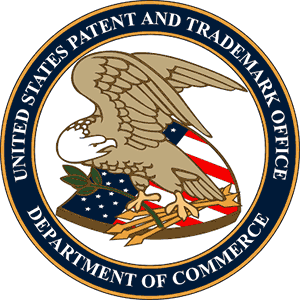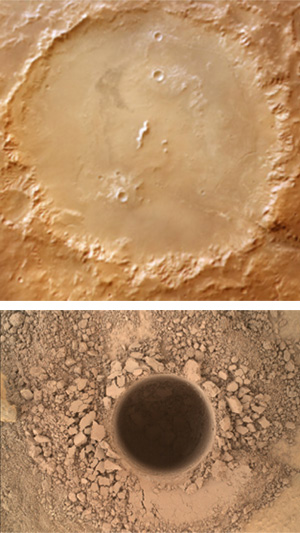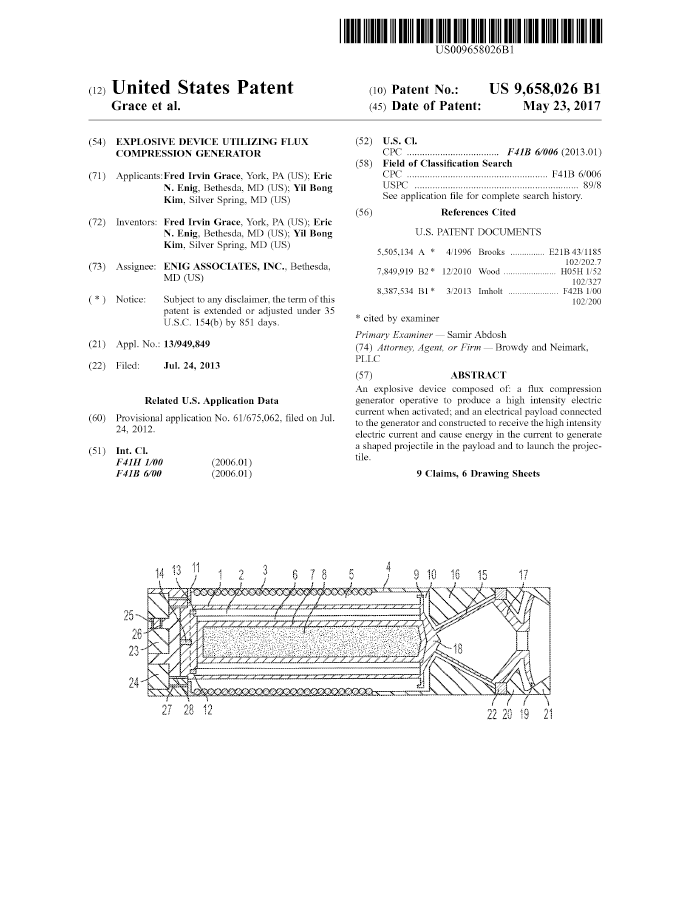 Enig Associates, Inc. (“ENIG”), the inventor and developer of the Magnetohydrodynamic Explosive Munition (MAHEMTM), and more recently Hybrid Electromagnetic Gun (HyGUNTM), was awarded today a U.S. patent entitled Explosive Device Utilizing Flux Compression Generator (Patent No. 9,658,026; Application 13/949,849) (“FLUXGENTM”). ENIG’s FLUXGENTM technology provides the ability to drive kinetic energy penetrators and have multiple kinetic energy effects, representing a breakthrough technology for the warfighter. Equally important, this newly-issued patent brings to fruition ENIG’s efforts to develop compact, scalable, man-portable sources of high current and magnetic flux to rival U.S. Department of Energy’s (DOE) pulsed power Z and Saturn machines.
Enig Associates, Inc. (“ENIG”), the inventor and developer of the Magnetohydrodynamic Explosive Munition (MAHEMTM), and more recently Hybrid Electromagnetic Gun (HyGUNTM), was awarded today a U.S. patent entitled Explosive Device Utilizing Flux Compression Generator (Patent No. 9,658,026; Application 13/949,849) (“FLUXGENTM”). ENIG’s FLUXGENTM technology provides the ability to drive kinetic energy penetrators and have multiple kinetic energy effects, representing a breakthrough technology for the warfighter. Equally important, this newly-issued patent brings to fruition ENIG’s efforts to develop compact, scalable, man-portable sources of high current and magnetic flux to rival U.S. Department of Energy’s (DOE) pulsed power Z and Saturn machines.
“Looking back over the last several decades, most flux compression generators have been, relatively speaking, quite large and with low current gains. Over the last several decades, applications for the warfighter have not been forthcoming, as these FCGs tend to have low output, are extremely bulky, and make for awkward packaging into weapons payloads sections in missiles and projectiles, as well as in air vehicle carriages. That doesn’t even begin to address the issue of external power source requirements,” noted ENIG President, Eric N. Enig, and co-inventor of FLUXGENTM, the second generation of MAHEMTM technology.
For years, the U.S. Army labs, AMRDEC (Redstone Arsenal) and ARDEC (Picatinny Arsenal), and the Air Force Service labs, AFRL/RW (Eglin AFB) and AFRL/RD (Kirtland AFB), have sought to upgrade current munitions with multiple effects (e.g., dial-a-yield, scalable effect, non-lethal EMP, etc.). Conventional technologies, with iterative improvements, have not delivered revolutionary increases in capability, for the warfighter. FLUXGENTM offers DoD and DOE a robust test bed for next-generation devices, at a fraction of the cost, with orders-of-magnitude reduced experimental complexity.
What about civilian and non-DoD applications for FLUXGENTM?
 Having a highly insensitive energetic material at the heart of ENIG’s FLUXGENTM technology lends itself as a very useful tool for planetary exploration. Safely transportable, with known storage and operational procedures, means that FLUXGENTM can be used for planetary surface and subsurface exploration and interrogation. “Currently, NASA engineers working subsurface exploration are actively seeking alternative methods for penetrating into Mars’ subsurface, specifically at a depth of 200 meters. This, they want to do fluidlessly and without heavy equipment, steel casings, etc.” notes Enig, adding that NASA is clearly moving beyond shallow surface exploration. “As a compact, relatively lightweight device, FLUXGENTM has the ability to provide a tailored bore size into various surface materials. Using multiple FLUXGENTM devices at specified depths, the objective of achieving NASA’s desired depth is more realistic than ever,” said Enig, who noted that with this technology, researchers can also remotely probe Mars’ subsurface by generating multiple shockwaves into rock formations and observe seismic activity at various locations, through use of unattended sensors.
Having a highly insensitive energetic material at the heart of ENIG’s FLUXGENTM technology lends itself as a very useful tool for planetary exploration. Safely transportable, with known storage and operational procedures, means that FLUXGENTM can be used for planetary surface and subsurface exploration and interrogation. “Currently, NASA engineers working subsurface exploration are actively seeking alternative methods for penetrating into Mars’ subsurface, specifically at a depth of 200 meters. This, they want to do fluidlessly and without heavy equipment, steel casings, etc.” notes Enig, adding that NASA is clearly moving beyond shallow surface exploration. “As a compact, relatively lightweight device, FLUXGENTM has the ability to provide a tailored bore size into various surface materials. Using multiple FLUXGENTM devices at specified depths, the objective of achieving NASA’s desired depth is more realistic than ever,” said Enig, who noted that with this technology, researchers can also remotely probe Mars’ subsurface by generating multiple shockwaves into rock formations and observe seismic activity at various locations, through use of unattended sensors.
(For more information, contact media@enig.com.)

